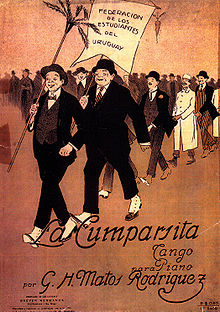- La cumparsita
-
"La cumparsita" is a musical piece written by Gerardo Matos Rodríguez, an Uruguayan musician, in 1916. It is among the most famous and recognizable tango songs of all time.[1][2]
The title translates as "the little parade", and the first version was a tune with no lyrics. Later, Pascual Contursi wrote words to make the most popular version of the song. The lyrics begin: "The little parade of endless miseries..."
Contents
History
The song was originally a Uruguayan carnival march whose melody was composed in early 1916 by an architecture student in Montevideo, an 18-year-old man named Gerardo Hernán "Becho" Matos Rodríguez, the son of Montevideo's Moulin Rouge nightclub proprietor Emilio Matos. On 8 February 1916, Matos Rodríguez had his friend Manuel Barca show orchestra leader Roberto Firpo the music in the cafe called La Giralda. Firpo looked at the music and quickly determined that he could make it into a tango. As presented to him it had two sections; Firpo added a third part taken from his own little-known tangos "La gaucha Manuela" and "Curda completa", and also used a portion of the song "Miserere" by Giuseppe Verdi from the opera Il trovatore.[3][4] Years later, Firpo reported the historic moment as follows:
"In 1916 I was playing in the café La Giralda in Montevideo, when one day a man was accompanied by about fifteen boys—all students—to say he brought a carnival march song and they wanted me to review it because they thought it could be a tango. They wanted me to revise and tweak the score that night because it was needed by a boy named Matos Rodríguez. In the 2/4 [march time signature] score there appeared a little [useful melody] in the first half and in the second half there was nothing. I got a piano and I remembered my two tangos composed in 1906 that had not had any success: "La gaucha Manuela" and "Curda completa". And I put in a little of each. At night I played the song with "Bachicha" Deambroggio and "Tito" Roccatagliatta. It was an apotheosis. Matos Rodríguez walked around like a champion... But the tango was forgotten, its later success began when the words of Enrique Maroni and Pascual Contursi were associated with it."[5]Firpo recorded the song in November 1916 for Odeon Records: Odeon release number 483.[3] He used the recording studio of Max Glücksmann in Buenos Aires, and employed two violinists, one bandoneón player (Juan Bautista "Bachicha" Deambrogio), and one flute player to join him as bandleader on piano.[6] The song was pressed as the B-side of a 78 rpm release, and had only a modest success, fading in familiarity after several years.[6]
Lyrics to the song were written by the Argentine Pascual Contursi in 1924, and soon became a hit. This version of the song is considered the most widely known tango song in the world, closely followed by "El Choclo".[7] Contursi recorded the song under the title "Si Supieras" ("If you knew"). Living in Paris at that time, Matos Rodríguez discovered that the song was a big hit when he talked with Francisco Canaro who was playing the tune at Paris engagements as "Si Supieras". Canaro told Matos Rodríguez the song was "all the rage by all the orchestras".[6] Matos Rodríguez spent the next two decades in various court battles over royalties, and finally succeeded in ensuring that "La cumparsita" was re-established as the title of the song. However, Contursi's lyrics became intimately associated with the song.
Canaro formulated a binding agreement in 1948, one which would end the lawsuits. He determined that 20 percent of all royalties would go to the estates of the lyricist Contursi and his business partner Enrique P. Maroni. The other 80 percent of recording royalties would go to the estate of Matos Rodríguez. Canaro established that future sheet music printings would show Contursi's lyrics in addition to less well-known ones written by Matos Rodríguez, and no other lyrics.[6]
Legacy
Famous versions of this tango include Carlos Gardel's vocal and performances by orchestras led by Juan d'Arienzo and Osvaldo Pugliese. La Cumparsita is very popular at Milongas; it is a common tradition for it to be played as the last dance of the evening.
The song was named cultural and popular anthem of Uruguay by law.[8] in 1997.[9] [10]
Gene Kelly dances to "La cumparsita" in the film Anchors Aweigh (1945). The song was included in a ballroom scene of the film Sunset Boulevard (1950) in which Gloria Swanson and William Holden danced the tango. In the 2006 dance movie Take the Lead, Jenna Dewan, Dante Basco and Elijah Kelley danced to a remixed version.[11]
Olympic controversy
In the Olympic Games of Sydney 2000, the Argentine team marched to "La cumparsita". This originated protests and official claims from the Uruguayan government.[12]
References
- ^ Gusman, Luis (2000). "La Cumparsita". CRC Press. p. 462 (restricted online copy at Google Books). ISBN 9780415229715.
- ^ Bethell, Leslie (1995). Cambridge university Press. p. 361 (restricted online copy at Google Books). ISBN 9780521495943.
- ^ a b Blaya, Ricardo García. "La cumparsita" (in Spanish). Las Historias: Tangos y Leyendas. Todo Tango. http://www.todotango.com/spanish/biblioteca/cronicas/la_cumparsita.asp. Retrieved 1 March 2011.
- ^ Rios, Carlos. "Historia de "La cumparsita"" (in Spanish). Trabajos. Congreso Internacional Quien Es Gardel. http://www.quienesgardel.com.ar/trabajos/cumparsita.html. Retrieved 1 March 2011.
- ^ Selles, Roberto; Pinsón, Néstor. "Roberto Firpo" (in Spanish). Los Creadores. Todo Tango. http://www.todotango.com/Spanish/Creadores/rfirpo.html. Retrieved 1 March 2011.
- ^ a b c d Braverman, Eran. "La Cumparsita – The Most Famous Tango Song". Very Tango. http://www.verytango.com/la-cumparsita.html. Retrieved 1 March 2011.
- ^ The 90's "Tango of the tangos"
- ^ Ley 16.905
- ^ Página/12 Web :: espectaculos :: ¿Quién no conoce “La Cumparsita”?
- ^ Globovision.com - La mítica Cumparsita jalona triángulo turístico Argentina-Chile-Uruguay
- ^ "Soundtracks for Take The Lead (2006)". IMDb. http://www.imdb.com/title/tt0446046/soundtrack. Retrieved 1 March 2011.
- ^ Article on BBC.co.uk
See also
Categories:- Tangos
- Spanish-language songs
- 1916 songs
Wikimedia Foundation. 2010.

